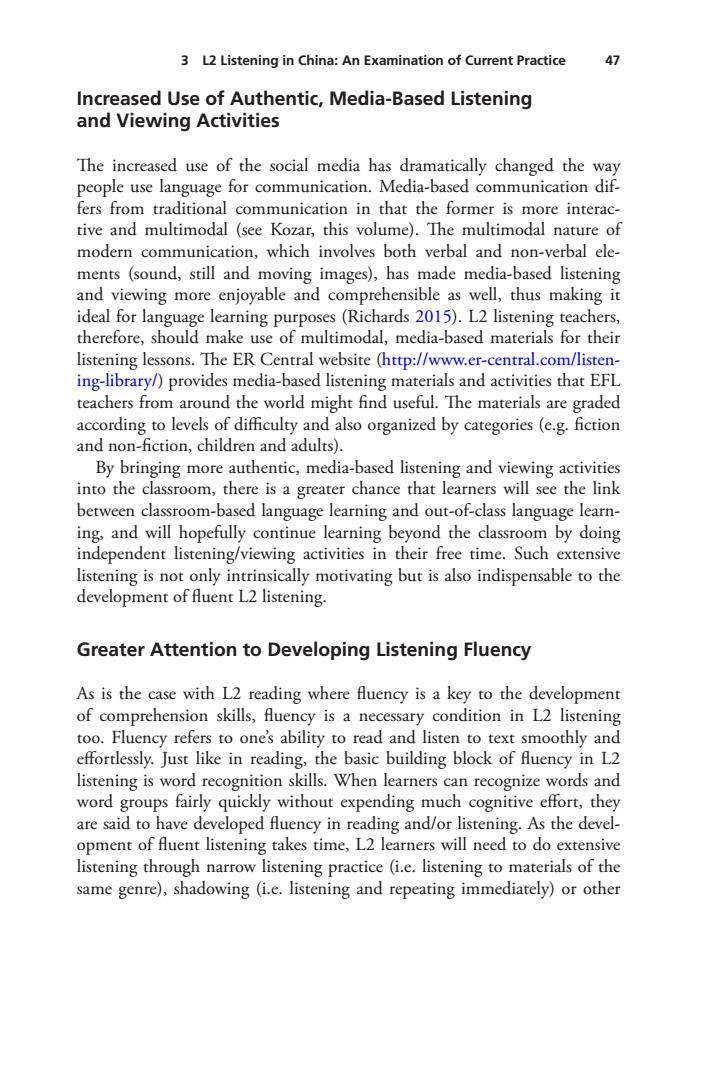正在加载图片...

3 L2 Listening in China:An Examination of Current Practice 47 Increased Use of Authentic,Media-Based Listening and Viewing Activities The increased use of the social media has dramatically changed the way people use language for communication.Media-based communication dif fers from traditional communication in that the former is more interac- tive and multimodal (see Kozar,this volume).The multimodal nature of modern communication,which involves both verbal and non-verbal ele- ments (sound,still and moving images),has made media-based listening and viewing more enjoyable and comprehensible as well,thus making it ideal for language learning purposes(Richards 2015).L2 listening teachers, therefore,should make use of multimodal,media-based materials for their listening lessons.The ER Central website (http://www.er-central.com/listen ing-library/)provides media-based listening materials and activities that EFL teachers from around the world might find useful.The materials are graded according to levels of difficulty and also organized by categories (e.g.fiction and non-fiction,children and adults). By bringing more authentic,media-based listening and viewing activities into the classroom,there is a greater chance that learners will see the link between classroom-based language learning and out-of-class language learn- ing,and will hopefully continue learning beyond the classroom by doing independent listening/viewing activities in their free time.Such extensive listening is not only intrinsically motivating but is also indispensable to the development of fluent L2 listening. Greater Attention to Developing Listening Fluency As is the case with 12 reading where fluency is a key to the development of comprehension skills,fluency is a necessary condition in L2 listening too.Fluency refers to one's ability to read and listen to text smoothly and effortlessly.Just like in reading,the basic building block of fluency in L2 listening is word recognition skills.When learners can recognize words and word groups fairly quickly without expending much cognitive for,they are said to have developed fluency in reading and/or listening.As the devel- opment of fluent listening takes time,L2 learners will need to do extensive listening through narrow listening practice (i.e.listening to materials of the same genre),shadowing (i.e.listening and repeating immediately)or other 3 L2 Listening in China: An Examination of Current Practice 47 Increased Use of Authentic, Media-Based Listening and Viewing Activities Te increased use of the social media has dramatically changed the way people use language for communication. Media-based communication differs from traditional communication in that the former is more interactive and multimodal (see Kozar, this volume). Te multimodal nature of modern communication, which involves both verbal and non-verbal elements (sound, still and moving images), has made media-based listening and viewing more enjoyable and comprehensible as well, thus making it ideal for language learning purposes (Richards 2015). L2 listening teachers, therefore, should make use of multimodal, media-based materials for their listening lessons. Te ER Central website (http://www.er-central.com/listening-library/) provides media-based listening materials and activities that EFL teachers from around the world might fnd useful. Te materials are graded according to levels of difculty and also organized by categories (e.g. fction and non-fction, children and adults). By bringing more authentic, media-based listening and viewing activities into the classroom, there is a greater chance that learners will see the link between classroom-based language learning and out-of-class language learning, and will hopefully continue learning beyond the classroom by doing independent listening/viewing activities in their free time. Such extensive listening is not only intrinsically motivating but is also indispensable to the development of fuent L2 listening. Greater Attention to Developing Listening Fluency As is the case with L2 reading where fuency is a key to the development of comprehension skills, fuency is a necessary condition in L2 listening too. Fluency refers to one’s ability to read and listen to text smoothly and efortlessly. Just like in reading, the basic building block of fuency in L2 listening is word recognition skills. When learners can recognize words and word groups fairly quickly without expending much cognitive efort, they are said to have developed fuency in reading and/or listening. As the development of fuent listening takes time, L2 learners will need to do extensive listening through narrow listening practice (i.e. listening to materials of the same genre), shadowing (i.e. listening and repeating immediately) or other